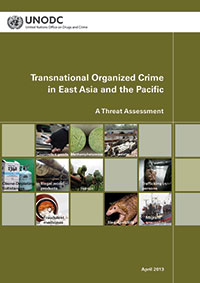 Bangkok (Thailand), 25 April 2013 - UNODC's recently released report, Transnational Organized Crime in East Asia and the Pacific - A Threat Assessment, makes it clear that environmental crimes are emerging as very serious global threats that cannot be underestimated any longer.
Bangkok (Thailand), 25 April 2013 - UNODC's recently released report, Transnational Organized Crime in East Asia and the Pacific - A Threat Assessment, makes it clear that environmental crimes are emerging as very serious global threats that cannot be underestimated any longer.
International criminal syndicates are making an obscene amount of money at the environment's expense: Environment crimes generate an estimated USD 23 billion annually - over one quarter of the nearly USD 90 billion earned per year in East Asia and the Pacific by transnational organized crime.
The criminal syndicates operating the illegal trade in timber, wildlife and hazardous substances are engaged in sophisticated forms of transnational organized crime that are as deadly serious as the international illicit trades in people, drugs, fake goods and fraudulent medicines.
Yet the response by Governments and the international community in terms of legislation, law enforcement, criminal analysis and international cooperation to this international criminal activity has been inadequate and has allowed criminal networks to exploit weak laws and sanctions, under-resourced capacities in law enforcement and a lack of coordination between competent authorities. Very few environmental crime offenders are ever investigated, tried or convicted.
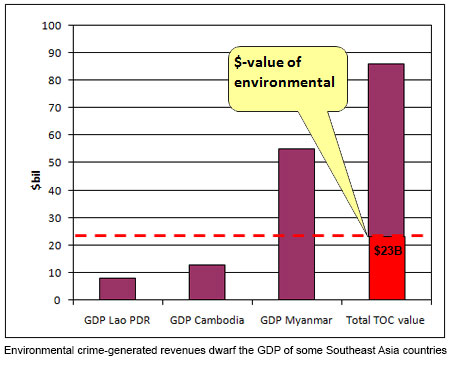
The Threat Assessment proposes twenty possible responses to address specifically the link between crime and environmental degradation in East Asia and the Pacific, based on a combination of preventive, repressive and regulatory measures. Among them, the Threat Assessment calls for a recognition of the illegal trade in wildlife and timber as serious forms of transnational organized crime. In this context, the ongoing efforts to obtain such recognition at the 2013 Commission on Crime Prevention and Criminal Justice are particularly timely and opportune.
A continued inadequate response would have catastrophic consequences for the environment - and for the planet's security and human development. The unspeakable violence and the bloodshed associated to the booming trade of ivory and rhino horns from Africa is evidence of the struggle that confronts Governments.
According to the report, the illegal harvesting and trafficking of timber alone is worth a staggering US$17 billion dollars per year - making illegal timber more lucrative than the illicit trades in heroin (US$16.3 billion) or methamphetamine (US$15 billion). This illegal trade flourishes in the cracks of the legitimate timber trade, and is fuelled by corruption, fraud, lax regulation and poor enforcement.
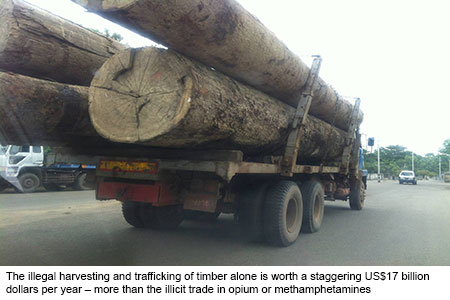
The booming illegal wildlife trade in Southeast Asia and the Pacific has deep, negative consequences on biodiversity here, in Africa and around the globe.
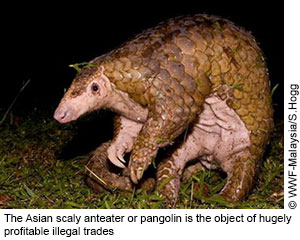 In Asia, the tiger is on the brink of extinction, while less well known local species like the Asian scaly anteater or pangolin are the object of hugely profitable illegal trades. The calculation of the financial value of this trade is complex, yet the Threat Assessment conservatively estimates this market to be worth US$2.5 billion a year, excluding offshore fishing and other sub-markets.
In Asia, the tiger is on the brink of extinction, while less well known local species like the Asian scaly anteater or pangolin are the object of hugely profitable illegal trades. The calculation of the financial value of this trade is complex, yet the Threat Assessment conservatively estimates this market to be worth US$2.5 billion a year, excluding offshore fishing and other sub-markets.
Transnational criminal networks not only plunder biological wealth like forests and wildlife, but also contribute to the degradation of water, air and soil and the thinning of the ozone layer.
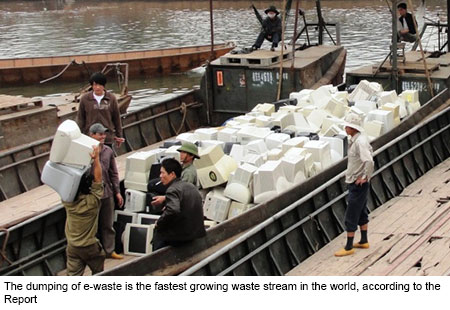
Due to the rapid turnover of electronic devices, the dumping of e-waste is the fastest growing waste stream in the world - valued in East Asia and the Pacific at US$3.75 billion annually. It is estimated that ten million tons of old computers, televisions, printers and mobiles phones are smuggled every year throughout the region by unscrupulous brokers and criminal networks who ship e-waste from Europe and the US to Asia.
Ozone-depleting substances (ODS), used for refrigeration and air-conditioning, have been gradually phased out since the Montreal Protocol (1987). However, the production and consumption of ODS still occurs in East Asia and an estimated 3,660 tons of illegal ODS flow from and within this region each year, worth an estimated US$67.7 million.
There is little time to waste.
When environmental resources like primary forests and wildlife species are gone, they are gone forever. In this case, what goes around will not come around - ever again.